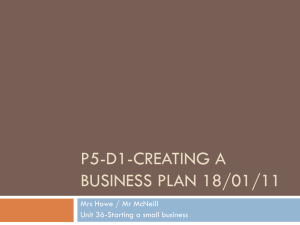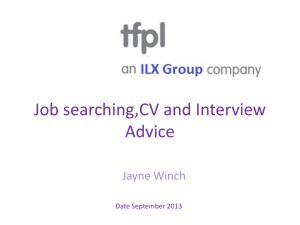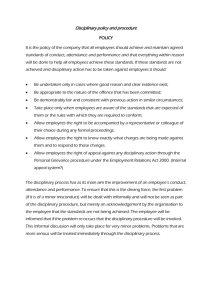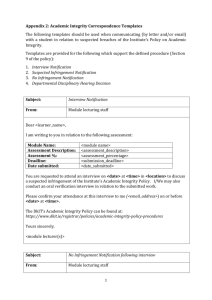Discipline and Dismissal
advertisement
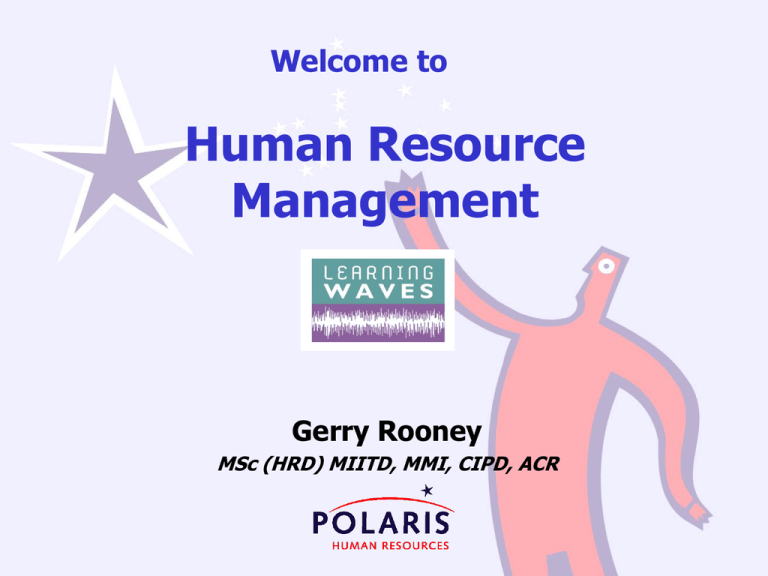
Welcome to Human Resource Management Gerry Rooney MSc (HRD) MIITD, MMI, CIPD, ACR Introductions • Name and Background • Typical problems you face in your role • What topics do you want covered over the course Course Outline Unit 1: Role of HR in the organisation Unit 2: Recruitment, Selection, Integration and Termination Unit 3: Employee Relations, Welfare and Health and Safety Unit 4: Compensation and Benefits Unit Two • Selection Recruitment, • Integration (Training & Development) • Termination a. Analyse a job and prepare the necessary documentation a. Carry out the process of recruitment and selection effectively b. Identify the training and development needs of your staff and evaluate the effectiveness of the subsequent training Nine Counts of Discrimination 1. 2. 3. 4. 5. 6. 7. 8. 9. Gender Age Martial Status Family Status Sexual Orientation Religion Race Disability Travelling Community The Job/Person Specification Seven Point Plan Attributes Attainments General Intelligence Specific Attitudes Interests Disposition/Attitude Circumstances Five Fold Grading System Impact on others Acquired Qualifications Innate Abilities Motivation Adjustment Job Description Exercise 1. 2. 3. 4. 5. 6. 7. 8. 9. Job Title Reports to / Location Company Background Responsible for (authority) Overall Purpose Main Task and Key Responsibilities Specific Objectives and Tasks Other Rewards & Conditions Person Specification Exercise 1. 2. 3. 4. 5. 6. 7. Job Title Reports to / Location Educational Standard Work Experience Knowledge Skills Competencies, Attitudes and Attributes Advertisement a. b. c. d. e. f. g. Job title Job description/ location Qualifications required Terms of employment Type of person you are looking for How candidates should apply Closing date Be careful of discriminatory grounds THE INTERVIEW ENVIRONMENT Quiet environment Comfortable temperature and soft lighting Comfortable seating and a glass of water Establish a distance that facilitates communication Seating arrangements that allows eye contact Reduce distractions Reduce barriers GENERAL STRUCTURE Introduction / Ice Breaker Build Rapport Overview of interview Explain Note taking Warm up question Planned questions Summarise and close / Have they anything to add? Question Techniques • • • • • • • Direct and indirect questions Leading questions Trick questions Hypothetical or Theoretical Questions Multiple or complex questions Negative questions Controlling questions Questioning • • • • Open questions – prompting as you go Showing interest / Smiles Probing Controlling the interview through your questions • Don’t let the candidate decide what the best answer is • Practice and preparation • Note taking – memory triggers Prepare and Conduct an Interview • Each person prepare an individual interview containing questions on 4 to 5 competencies needed (15 minutes per interview) • Follow general structure • Take notes • Complete notes once interview is over Prepare and Conduct an Interview • Can have up to two questions per competency • Interview: (1 Interviewer: 1 Interviewee: 2 Observers) – Switch • Mark out of five (1 = poor 5 = excellent) for each competency • Debrief with everybody at the end Points of Law • • • • • 9 counts of discrimination The use of the Application form is the preferred option Ask them have they anything else to add Keep notes for 12 months Write to candidate saying appointment made with satisfactory references and medical examination – looking for consent • Contract in 2 months of commencement The Blend of Team Roles Activist Analyst Successful Teamwork Observer / Sweeper Grafter Training & Development a. b. c. d. e. f. g. What is training & development How to T&D staff Explain difference between T&D List reasons why staff need to be trained List the conditions for effective T&D to occur Explain the learning curve Identify your responsibility - Understand why T&D is important - Identify your role - Implement T&D in your section/team Training Needs Analysis • Stage 1: Organisational needs • Stage 2: Departmental needs – departmental managers • Stage 3: Individual needs – departmental manager with individual staff members The Learning Process Acquiring New Knowledge or Skills • Knowledge is the What, How, Why, Where, When and Who • Skill is the ability to do something • Learning is the result of someone doing or knowing something that they did not know Learning • The Five Senses – – – – 20% 30% 50% 70% of of of of what what what what we we we we hear see hear and see do! Tell - Show - Practice Adult Learning Principals • 25-40 Minutes • Process 5-9 chunks of information • Self Directed • Goal Orientated • Take Errors Personally • Take Longer- but more accurate • Integrate new with previous Coaching Styles TELLING ASSESSOR Try and I’ll watch TUTOR Here’s what to look for (What I Saw) (What You Felt) DEMONSTRATOR STIMULATOR Copy Me How would you? ... Why do you think? … ASKING THE FOUR STEP INSTRUCTION TECHNIQUE Step 1: Prepare to Learn •Put the learner at ease •State the job, subject and objectives •Check current skill and knowledge •Create an interest in learning •Ensure the correct position of learner Step 2: Present the Subject • Tell, show or illustrate the subject • Present the material in logical steps • Stress key points • Be clear and assure understanding • Pace the learning process • Follow a set plan in digestible chunks Step 3: Test the Learning • Require learner to explain/demonstrate • Correct and serious errors • Check understanding of subject • Practice until target standard achieved Step 4: Put into Practice • Point out learner’s responsibilities • Indicate further help and guidance • Encourage final questions • Discuss and arrange follow up JOB BREAKDOWN AND TASK ANALYSIS • Job: A collection of tasks which constitute the work of one person • Task: A major element or step in the work process which is intended to achieve a specific result JOB BREAKDOWN PROCEDURE Job Breakdown Job ________________ Task ________________ STAGE KEY POINTS PERFORMANCE MANAGEMENT IS ABOUT ADDRESSING 4 KEY, SIMPLE QUESTIONS 1. WHAT IS MY ROLE WITHIN MY TEAM/UNIT? 2. WHAT MUST I ACHIEVE TO FULFILL MY ROLE SUCCESSFULLY? 3. HOW AM I GETTING ON AT THE MOMENT? 4. WHAT DO I NEED TO IMPROVE? OVERVIEW OF PERFOREMANCE MANAGEMENT STRATEGY / GOALS FOR YOUR RADIO STATION ANNUAL PLANNING PROCESS PERFORMANCE MGMT. SYSTEM PERFORMANCE PLANNING ONGOING MANAGEMENT ANNUAL PERFORMANCE & DEVELOPMENT REVIEW Why Feedback Is Important PRAISE BUILDS CONFIDENCE BUILDS COMPETENCE FOR GAINING CONTRIBUTION TIMELY ADVICE EXERCISE Think of specific occasions when you received feedback…. • Think of 2 –3 constructive examples – what did the person do •Think of 2-3 examples when it was les constructive – what did the person do. PRINCIPLES OF FEEDBACK Clear and structured Relevant & Objective CONTENT Focused and specific Timely Based on Solid evidence PRINCIPLES OF FEEDBACK Check your Assumptions and Judgements Maintain Adult - Adult Communication PROCESS PuT recipient at ease Listen Actively Maintain Self- Esteem GIVING BEHAVIOURAL FEEDBACK 1. Pick the right moment Public – positive feedback Private – critical feedback 2. Make the feedback timely 3. Specify the behaviour 4. Specify the impact / consequences 5. Use the golden rule of feedback (5 x positive – 1 x negative) 6. Give feedback / observations calmly 7. Invite a response 8. Look to the future 9. Be aware of your style and prejudices. Unit Three • Employee Relations and Health and Safety Employee Relations Society is: • Open & Mobile • Politically Democratic • Accessible Education and Career Routes • Welfare State • Spread of Property Ownership The Pluralist Model • Legitimacy of the Trade Union • Views Conflict as Logical and Inevitable • Establishes Procedures to support the Model ER and the Role of the Supervisor • Understand the IR machinery • Legitimate Right to Manage Staff • Facilitate reasonable employee concerns • Support and be supported by boss/organisation • Appreciate the role of the TU Understanding the National IR Framework • The Institutions • The Role Players • The processes and Procedures • The Issues The Trade Union • Legislation 1941 Act, 1990 Act • Role of the TU- adjust the bargaining power • Organisation of TUs Approaches to IR • • • • Adversarial Traditional Partnership Power Sharing • Policies and Strategies • Partnership Discipline and Dismissal Example of “Fair” Dismissal • Capability • Conduct • Qualification • Redundancy - Fair selection • Legal prevention • Expiry of fixed term or specified purpose contracts Discipline and Dismissal Examples of “Unfair” Dismissals • Trade union membership / activity • Religious or political opinion • Taking legal proceedings • Pregnancy related matter • Race or colour • Age • Membership of travelling community • Sexual orientation Key Problems? • Management Style (Inconsistent v Consistent) • Systematic Approach (Procedures) • Conducting Effective and Fair Interviews/ Hearings • Facts or Assumptions? Management Style • Proactive • Style & Behaviour – constructive relationships • Active Listening • Consistent Systematic Approach • Use the Procedures • Apply the appropriate Levels from Verbal Warning to Dismissal • How you apply the procedures • Proper Investigations/Hearings Disciplinary Stages Dismissal Suspension Written Warning Formal Oral Warning Counselling / Coaching Action Not taken Discipline and Dismissal- The Pit Falls • Section 14, Unfair Dismissals Act 1977 • “An employer shall, not later than 28 days after he enters into a contract of employment with an employee, give the employee notice in writing setting out the procedure which the employer will observe before, and for the purpose of dismissing an employee”. Discipline and Dismissal- The Pit Falls UD Acts 1977-2001 - Correct Procedure • Did you offer procedure? • Did you follow procedure? • Did you give written reasons? Natural Justice • Following must be observed • Principles of natural justice - Constitution – – – – – Must be presented with case against them Must be allowed representation Allowed opportunity to state their case Employer must hear/seen to hear case Employer must form judgment considering all facts Discipline and Dismissal Conduct of Disciplinary Meeting • • • • Two employer representatives present Present evidence to employee Consider employee response Adjourn to make decision Disciplinary Stages Dismissal Suspension Written Warning Formal Oral Warning Counselling / Coaching Action Not taken Aim of the Initial Interview • Inform of unsatisfactory behaviour • Discover why this occurred • Prevent reoccurrence or deterioration • Opportunity to improve • Corrective action • Clarify expected standards The Disciplinary Interview/Hearing • Fair Procedures – The rule against perceived bias – The rule requiring a fair hearing • The Four Rules – – – – Location Language Records Take your time The Disciplinary Interview/Hearing • Prepare – Identify the problem, check facts/assumptions – Inform and set meeting time • The Hearing – – – – – – – State nature of alleged offence Time and place Seriousness of the offence State no decision has been taken Ask for a response Use of language Questioning (Open to closed) Categories and Types of Evidence • • • • • • • • Direct/Original evidence Circumstantial evidence Hearsay evidence Weight of evidence Credibility Oral evidence Documentary evidence Real evidence The Disciplinary Interview/Hearing • Action – – – – – – – Expectations Previous Behaviour Mitigating Circumstances I.R.\E.R. Problems Precedents Adjournment Decision The Interview/Hearing • Follow UP – – – – – – The employee Staff Representative/Trade Union Management HR Dept. Others (if applicable) Records RELATIONSHIPS WHAT EFFECT WILL YOUR ACTION HAVE ON YOUR STAFF??? BUILD RELATIONSHIPS MISUSES OF PROCESS •TO ESTABLISH, CHANGE OR REINTRODUCE RULES •TO DEAL WITH COLLECTIVE OR GROUP PROBLEMS •TO ENHANCE PERSONAL OR SECTIONAL POWER •TO TEACH EMPLOYEES THE RULES EAT – Rules of Evidence • Quasi-judicial body • Chaired by a barrister or solicitor with employer and an employee representatives • Observes Common Law rules • Rules of Evidence often interpreted with flexibility Bullying- A Definition Any persistent act or conduct which is offensive, humiliating or intimidating, conducted by an individual or group either directly or indirectly, which makes the recipient feel upset, threatened, humiliated or vulnerable, or undermines self confidence. Bullying: The Legal Position • Health, Safety & Welfare at Work Act,1989 • Duty of Care- Common Law • Unfair Dismissals Acts 1977-1993 • Employment Equality Act, 1998, 2004 • Sexual Harassment



